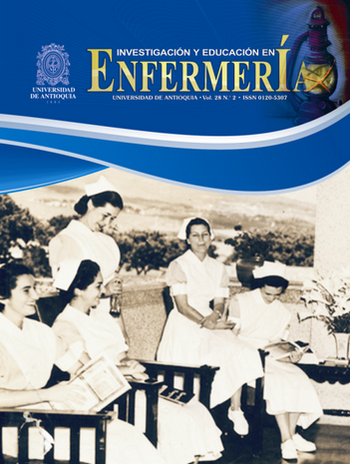Comparison of the pain severity, drug leakage and ecchymosis rates caused by the application on tramadol intramuscular injection in Z-track and Air-lock techniques
DOI:
https://doi.org/10.17533/udea.iee.6385Keywords:
Randomized controlled trials as topic; pain, injections; intramuscular.Abstract
Objective. To compare the pain severity caused by the application of the Z-track and Air-lock intramuscular injections.
Methodology. Unblinded clinical trial, where 90 female subjects aged between 18 and 60 years old were randomly assigned to two groups; the first group received the tramadol intramuscular injection using the Z-track technique (ZT) and the second group received it through the air- lock method (AL). A 10 centimeter linear visual scale was used to evaluate the injection pain. The scale length was considered as the pain severity. Data were analyzed using the SPSS version 13. Groups’ age, Body Mass index (BMI), and pain intensity were compared using unpaired student’s t test.
Results. The study showed that the pain severity of patients in the AL method group was lower than in the ZT technique group (p< 0.05). There was no significant statistical difference between the age, the number of injections previously applied and the BMI between the groups.
Conclusion. AL method produced less pain than the ZT technique; therefore it can be considered a better choice for intramuscular injections.
Downloads
References
(1) Kozier B, Erb G, Berman AJ, Burke K. Fundamentals of nursing: concepts, process and practice. 6th ed. New Jersey: Prentice Hall Health; 2006.
(2) World Health Organization. Safety of injections: a brief background [Internet]. Geneva: WHO [Consultado 2001 Mar 01]. Disponible en: http://www.who.int/inf- fs/en/fact231.html
(3) Potter PA, Perry A. Fundamentals of nursing. Tehran: Salemi editors;2007.p.960-963.
(4) Hay J. Complications at site of injection of dept neuroleptics. Br Med J. 1995; 311:421.
(5) Cupitt JM, Kasipandian V. Pain and intramuscular injections. Anaesthesia. 2004; 59(1):93
(6) Hasanpour M, Tootoonchi M, Aein F, Yadegarfar GH. The effects of two non-pharmacologic pain management methods for intramuscular injection pain in children. Acute pain. 2006; 8(1):7-12.
(7) Chung JW, Ng WM, Wong TK. An experimental study on the use of manual pressure to reduce pain in intramuscular injection. J Clin Nurs. 2002; 11(4): 457-61.
(8) Halperin BA, Halperin SA, McGrath P, Smith B, Houston T. Use of lidocaine-prilocaine patch to decrease intramuscular injection pain does not adversely affect the antibody response to diphtheria-tetanus-acellular pertussis-inactivated poliovirus-Haemophilus influenzae type b conjugate and hepatitis B vaccines in infants from birth to six months of age. Pediatr Infect Dis J. 2002; 21(5):399–405.
(9) Morishta A, Nakata Y, Sakamota CH, Takatani Y , Fujwara Y, Tsuda N. Effect of massage to reduce the pain of the intramuscular injection. Japanese J Nurs Res. 2002; 35(3):205-212.
(10) Mac Gabhann L. A comparison of two depot injection techniques. Nurs Stand. 1998; 12(37): 39-41.
(11) Keen MF. Comparison of intramuscular injection techniques to reduce site discomfort and lesions. Nurs Res. 1986; 35(4): 207-10.
(12) Ban T, Li LX, Pillay JJ. Compressed air injection technique to standardize block injection pressures. Can J Anesth. 2006; 53(11):1098-1102.
(13) Quartermaine S, Taylor R. A comparative study of dept injection techniques. Nurs Times.1995; 91(30):36-39.
(14) Kim KS. Comparison of two intramuscular injection techniques on the severity of discomfort and lesions at the injection site. Kanho Hakhoe Chi. 1988; 18(3):257-68.
(15) Parkhideh H, Sakineh M. Study of intramuscular effect injection with Z technique on pain, ecchymosis and drug leakage in site of injection. J Kerman Med Sci Univ.1997; 4(4):176-181.
Downloads
Published
How to Cite
Issue
Section
License
Derechos de propiedad / Direitos de Propriedade
English: If the article is accepted for publication, all copyright will be of exclusive property of Investigación y Educación en Enfermería. The text and the graphics included in the publication are exclusive responsibility of the authors and not necessarily reflect the thought of the Editorial Committee.
Español: Si el artículo es aprobado para publicación, todos los derechos son de propiedad de Investigación y Educación en Enfermería. El texto y las gráficas incluidas en la publicación son de exclusiva responsabilidad de los autores y no necesariamente refleja el pensamiento del Comité Editorial.
Português: Se o artigo for aceito para publicação, todos os direitos autorais serão de propriedade exclusiva de Investigación y Educación en Enfermería. O texto e os gráficos incluídos na publicação são de responsabilidade exclusiva dos autores e não refletem necessariamente o pensamento do Comitê Editorial.















